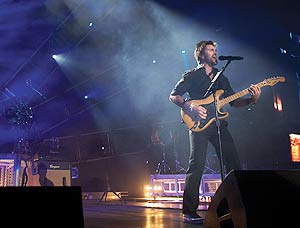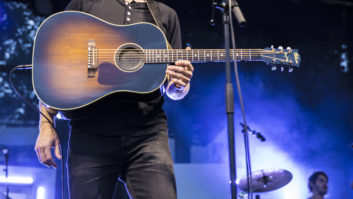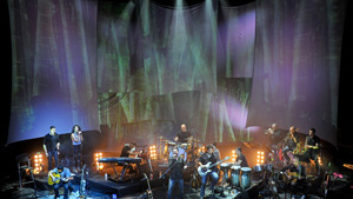
Mixing elements of rock, soul, funk, blues and Latin music, Columbian musician Juanes has risen to the top of the Latin music scene. His electrifying live shows attract sold-out audiences around the world, and his passionate support of political causes has earned him comparisons to Bono. He has also received critical acclaim, winning a total of 12 Latin Grammys and counting so far. Touring with his six-piece band (for a complete list, see the sidebar “Miking the Backing Band” on page 60) in support of his 2007 album, La Vida…Es Un Ratico, Juanes delivered a stellar performance at Denver’s Magness Arena, where Mix caught up with the tour midway through its trek across the country. Production is in the capable hands of front-of-house engineer Rob “Cubby” Colby, monitor engineer Anselmo Rota (who speaks very little English), monitor assistant Jordan Kolenc, system engineer Edgardo Vertanessian (of Eighth Day Sound) and system tech Craig Laskowski.
SOUND TRANSLATION
Colby got his introduction to Juanes at the 2000 Latin Grammy Awards. “I was doing other Latin artists and this drummer that’s with him now, Waldo Madera, came by this tour that we had done, the Living La Vida Loca tour with Ricky Martin, which was a really nice production,” Colby recalls. “Their front-of-house engineer had gone to be the monitor engineer, and I got the phone call. They had me come out to do a couple of shows, one in L.A. and one in Las Vegas, and everything went very well, and I really enjoyed mixing the music. I really enjoyed the artist, too.
Photo: John Johnston
“Even though he is singing in Spanish, you can still hear the emotion in what he is singing,” Colby continues. “I’ve never had a problem mixing an artist singing in Spanish. It’s more a feel than what the artist is singing about. I ask a lot of questions in rehearsals so I have some idea of what the song is about!”
Situated at FOH is a DiGiCo D5 board, which Colby says he’s been using for the past seven or eight years. “This type of footprint and its layout, for me, it’s all right there in front of me. Of course, the sound is great. It serves my purposes; I don’t need a lot of different things. I’m pretty consistent with the type of outboard gear I use, which is really a very minor amount. I mostly use what’s on the console. I have two external dynamics — two Distressors for the two different bass channels — and I have a couple Lexicon PCM units for reverbs. Otherwise, I use what’s on the console.”
Juanes likes to mimic the sound of his albums as closely as possible, so Colby puts minimal effects on the instruments. “I’ve just introduced a few little echo trails on some of the re-arrangements of the songs, which he likes a lot,” Colby explains. “I’m using some longer reverbs, and that’s really about it. There’s a slight 12-string guitar doubler that I use a little, just to give it some more warmth because it sounds so thick sometimes in the way that it’s played for this type of music; it’s really not strummed a lot. It’s an impact-type mix: Guitars out front and a real punchy drum sound.”
Colby has been recording all the shows with the goal of making a live record at some point next year. “I’m multitracking to Pro Tools,” he says. “We’ve got six 500-gig drives that we are filling up with all of the North American concert dates. We’re doing four out in L.A., and I think those are the ones he’s hoping to capture. I’m running 52 lines in, plus four audience microphones, two Neumann KM 184s at the stage and two Audio-Technica shotgun mics at FOH.”
Eighth Day Sound is providing a d&b audiotechnik line array system. According to the production company’s Vertanessian, “In this room, I’m flying 14 on the mains — 12 J8s and two J12s per side — and I’m flying eight Q1s for the side hangs per side. Then we have six J-SUBs flown and six B2-SUBs on the ground per side, as well as with six Q7 front-fills. It’s quite a significant P.A.” Vertanessian tunes the room using a combination of SIA Smaart, a d&b Ethernet system and a wireless Lake Controller tablet. Vertanessian works hard to compensate for the unusual geometry of Magness, the home arena for the Denver Pioneers hockey team. One side of the mostly concrete venue is significantly higher than the other: “The reflections are kind of annoying me,” Vertanessian says. “One side is way up with lots of seats and the other side is very low, so having the side hangs set up the same and sounding the same as the P.A. becomes very challenging.”
Colby, for one, appreciates the nuances of the d&b system. “I find that all of the line arrays nowadays, they only make the bad-sounding rooms sound much better because of the technology and the aiming programs. All the rooms are challenging, but I don’t think there’s such a thing as a bad-sounding room anymore. This is a rock show, so it’s a punchy, impact mix. It’s going to be loud, so by introducing that volume into the room and taking out all the excitable frequencies, these rooms can sound very good, but it’s very in-your-face, and that’s what these line arrays do for you. The d&b system, it’s very compact, very consistent, lightweight and extremely powerful. We’re covering 220 degrees with the full system.”
CROSS-CULTURAL PERSONNEL
In talking with Rota, who hails from Argentina, Vertanessian served as our translator. Rota started out as a DJ, and has worked for most of the major Latin tours during the past two decades; this is his first time working with Juanes. As the artist sings all of his songs in Spanish, it was important to him to have a Spanish-speaking monitor engineer.
“On the last tour, Juanes and his production were looking for a monitor engineer replacement because there were a couple of dates that the former monitor engineer couldn’t cover,” Rota says via Vertanessian. “They called me and I couldn’t make it because I had other shows to do. Finally, that monitor engineer left the production and they called me as the replacement. Juanes wanted a Latin mixer so he could talk to me in Spanish during the show to understand signs and words.”
Like Colby, Rota is mixing on a DiGiCo D5 console: “I’m very comfortable with it and think it’s the easiest to use as a monitor mixer,” he says. “I like the way it sounds and think it’s the best monitor desk available today. I use the onboard effects, as well. I have two reverbs — one for the acoustic guitars and one for the vocals — and use a compressor on the vocal and on the acoustic and the percussion and the conga.”
Rota is sending several different mixes out to the stage, some of which are then remixed by the musicians. “I run a stereo mix for the drummer — one with the band only and one with the drums only — and send him the click and Juanes’ vocal, and the drummer has a little console and he mixes the six feeds in his in-ears.
“The percussionist has a console, too. I mix a left/right for him and send him the click, and he has a lavalier microphone that gets all the toys that he plays on the percussion. He has a little desk and mixes the left/right, the click and the lavalier.
“The keyboard player has another console, and I mix left and right for the keyboard, plus I send him the click, the vocal and the keyboard player’s headset vocal.” The bass player and two guitar players use in-ear monitors, and Rota sends them a standard L/R mix.
As Juanes sings from both the stage and the end of a thrust (he sings through two Shure KSM9s — one onstage and one at the end of a thrust), he has two separate d&b M2 wedges onstage and two separate d&b M2 wedges at the end of the thrust. “Juanes wants to listen to everything, but his own voice and guitar are a little louder than the rest,” says Rota. “Juanes wants to keep the stereo image as he is playing, so the stage-right guitar and the keyboards are on his right, and the stage-left guitar player is on his left. What Juanes told me from the very beginning is he wants to listen [to the mix] as if he is listening to the record.”
Candace Horgan is a Denver-based writer.
Miking the Backing Band
Drummer Waldo Madera’s kit: Sennheiser e901 and e905 (snare), e904 (toms); Neumann KM 184 (overheads, hi-hats); Audio-Technica 2500 (kick).
Felipe Alzate’s percussion: Shure Beta 98s, Beta 52 (tambora) Beta 57s (djembe, top and bottom) and Neumann KM 184s.
Felipe Navia’s bass: Two Radial Dis.
Emmanuel Briceño’s keyboards: Eight Radial Dis panel, Moog, Motif, Rhodes, Wurlitzer
Juan Pablo Villamizar and Fernando Tobon’s guitars: Shure KSM 32s and an L/R on Juanes’ guitars (acoustic: Shure wireless sytem with Avalon Dis).





